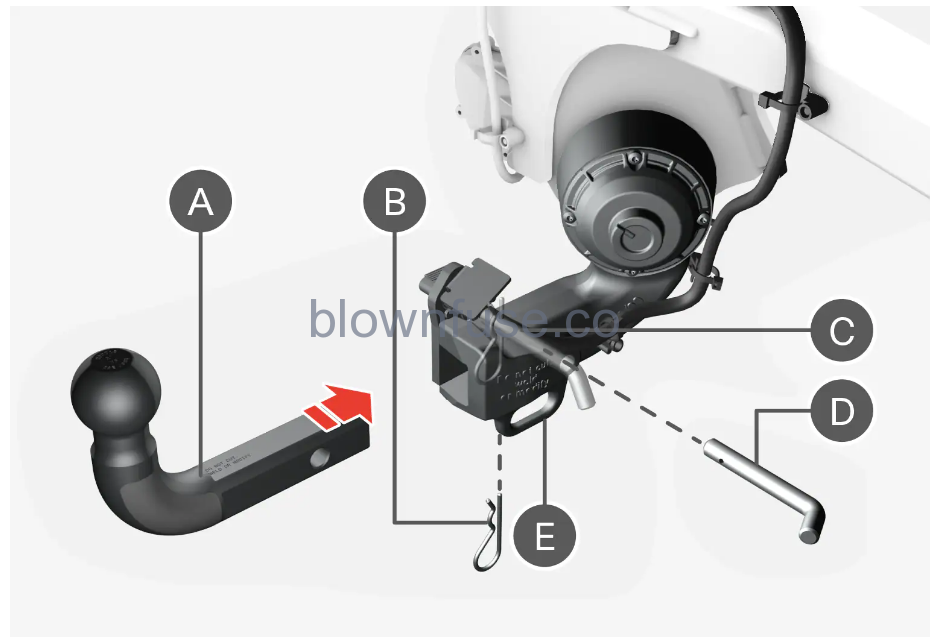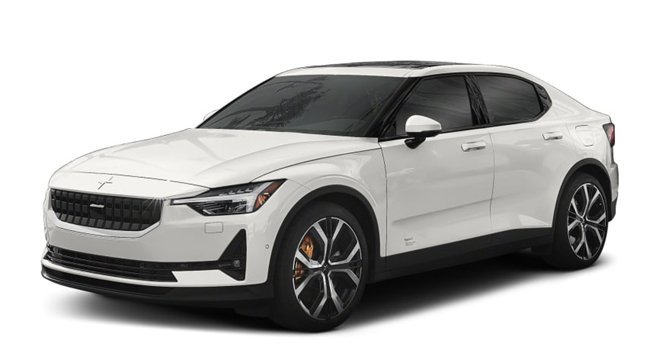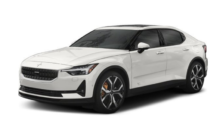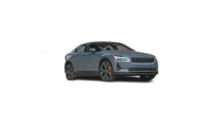Detachable towbar
The optional detachable trailer hitch may not be available in all markets or on all models. Contact Polestar Customer Support.

- If necessary, remove the cotter pin from the locking bolt and slide the locking bolt out of the towbar assembly.
- Slide the ball holder into the towbar assembly.
- Align the hole in the ball holder with the hole in the towbar assembly.
- Slide the locking bolt through the towbar assembly and ball holder.
- Insert the cotter pin in the hole at the end of the locking bolt.
- Make sure the towbar locks securely into place before connecting anything to it.
- Always secure the trailer’s safety chains or wires in the designated attachment points on the trailer.
- Remove the cotter pin from the locking bolt and slide the locking bolt out of the ball holder/towbar assembly.
- Pull the ball holder out of the towbar assembly.
The towbar could be damaged due to improper use or faulty extras, for example:
- Overloading extras.
- Using faulty extras.
- Using an extra for an unintended purpose.
- Using a weight-distributing towing system.
- Incorrectly positioned ball mount; see geometric constraints for the towbar.
When not in use, always store the detachable ball holder in its designated spot under the cargo compartment floor.
Driving with a trailer
Load-carrying capacity is determined by the vehicle’s curb weight. The total weight of all passengers and any installed extras, such as a towbar, reduces the vehicle’s load-carrying capacity by the corresponding amount.
- Towbars used on the vehicle must be approved for the applicable use.
- Distribute the load on the trailer so that the weight on the towbar complies with the specified maximum tongue weight. The tongue weight is calculated as part of the vehicle’s payload.
- Increase the tire pressure to the recommended pressure for a full load.
- The electric motor is subjected to more load than usual when towing a trailer.
- Towing a trailer affects the vehicle’s handling, durability, and driving economy.
- Do not drive with a heavy trailer when the vehicle is very new. Wait until the mileage has reached at least 1000 km (620 miles).
- Follow applicable regulations regarding permitted speed and weight.
- Drive slowly when towing a trailer up a long and steep incline.
- Avoid driving with a trailer on inclines of more than 12%.
- Avoid overloading and other incorrect use.
- The trailer’s brakes must be balanced with the vehicle’s brakes to help ensure safe stops (follow applicable local regulations).
- Auto Rear Brake should be deactivated before driving with a trailer.
- Bumper-attached trailer hitches must not be used on Polestars, nor should safety chains be attached to the bumper.
- Trailer hitches attaching to the vehicle’s rear axle must not be used.
- Never connect a trailer’s hydraulic brake system directly to the vehicle brake system, nor a trailer’s lighting system directly to the vehicle lighting system. Consult Polestar Customer Support for correct installation.
- When towing a trailer, the trailer’s safety chains or wire must be correctly fastened to the attachment points provided in the trailer hitch on the vehicle. The safety chain or wire must never be fastened to or wound around the towing ball.
The optional detachable trailer hitch may not be available in all markets or on all models. Contact Polestar Customer Support.
Follow the specified trailer weight recommendations. The vehicle and trailer may otherwise become difficult to control during evasive maneuvers and while braking.
The specified maximum trailer weights are those permitted by Polestar. Trailer weight and speed may be further restricted by national vehicle regulations. The towbars may be certified for a higher towing capacity than what the vehicle is permitted to pull.
- Depress the brake pedal.
- Activate the parking brake.
- Release the brake pedal.
Put chocks behind the wheels when the vehicle is parked on a hill with a trailer attached.
- Depress the brake pedal.
- Put the gear selector in D or R and press the accelerator pedal.
> The parking brake will release and the symbol in the instrument panel will go out. You can now drive.
Folding towbar
Follow the instructions to carefully fold the towbar in and out.
Do not push the button for folding in/out if a trailer is connected to the towbar.
A button for folding the towbar in and out is located on the right-hand side at the rear of the cargo compartment. The indicator light in the button will flash or glow steadily orange when the folding function is active.
- Press the button in the cargo compartment and release – pressing too long on the button may prevent the towbar from folding out.
> The towbar will fold out and down to an unlocked position – the indicator lamp will flash orange.
- Move the towbar to its end position, where it is fixed and locked into place.
> The indicator light glows steadily when the towbar is ready to be used.
Avoid standing near the center of the bumper behind the vehicle when the towbar is being folded out.
Make sure to attach the trailer’s safety chain or wire to the designated attachment point.
Power-saving mode is activated after a short period of time and the indicator light goes out. Closing and reopening the tailgate will reactive the system. This applies to both folding in and folding out the towbar.
If the vehicle electrically detects a connected trailer, the indicator light will stop glowing steadily.
- Press the button in the cargo compartment and release – pressing too long on the button may prevent the towbar from folding in.
Press the button in the trunk and release – pressing too long on the button may prevent the towbar from folding in.
> The towbar will fold down to an unlocked position – the indicator lamp will flash orange.
- Secure the towbar into position by pushing it back to its retracted position under the bumper, where it will lock into place.
> The indicator light glows steadily when the towbar is correctly folded in.
When the towbar has been activated by pressing the button and has been placed in the unlocked position:
Wait at least 2 seconds before moving the towbar to a locked position. If the towbar does not remain in the locked position, wait a few more seconds and then try again.
Do not kick the towbar.
Power-saving mode is activated after a short period of time and the indicator light goes out. Closing and reopening the tailgate will reactive the system. This applies to both folding in and folding out the towbar.
If the vehicle electrically detects a connected trailer, the indicator light will stop glowing steadily.
Make sure that there is no adapter in the electrical socket or removable ball mount mounted when the towbar is folded in.
Remove the bicycle holders from the towbar when it is not being used.
Maximum weight limits differ for trailers and towbar-mounted extras. Each has a different limit. This towbar is only designed for towbar-mounted bicycle holders. No other extra should be used.
Keep the following in mind when mounting a bicycle on the bicycle holder:
- Do not mount more than 4 bicycles
- The maximum weight for the bicycle holder including bicycles is 200 lbs/90 kg. Example: holder 40 lbs + 4 bicycles at 30 lbs each = 160 lbs total > OK
Polestar recommends only using original Polestar extras. Follow the instructions provided with the product.
- Never use towbar adapters or towbar extenders
- Only use ball mount for towing. Do not mount extras directly on the ball mount. Use extras designed to be mounted in the towbar’s square profile. Do not use extras designed to be attached around the ball.
- The use of a loaded basket is not permitted.
Always fold in the towbar when it is not being used.
Keep the following in mind
- Load the heaviest bicycle closest to the vehicle.
- If possible, load the bicycles symmetrically, as close to the center of the vehicle as possible.
- Remove detachable parts from the bicycle, such as baskets, batteries, or child seats. This will help reduce the load on the towbar and the bicycle holder.
- Do not use bicycle covers – this could increase the load on the towbar.
- Optional/accessory – The equipment described in the Manual is not available in all cars – the cars have different equipment depending on adaptations for the needs of different markets and national or local laws and regulations.
Towing capacity and tongue weights
| Max. trailer weight | USA (lbs)
| Canada (kg)
|
| Without brakes: | 1650 | 750 |
| With brakes: | 2000 | 900 |
| Max. tongue weight | 200 | 90 |
Trailer Stability Assist
Swaying may be caused by factors such as:
- The vehicle and trailer are hit by a sudden, strong crosswind.
- The vehicle and trailer are traveling on an uneven road or over a bump.
- Sudden movements of the steering wheel.
Once swaying has begun, it can be difficult or impossible to stop it. This makes the vehicle and trailer difficult to control and there is a risk of swerving into oncoming traffic or driving off the road.
If the Trailer Stability Assist function’s first attempt is not adequate to stop the swaying motion, the brakes are applied on all wheels and electric motor power is temporarily reduced. As the swaying motion begins to decrease and the vehicle and trailer have once again become stable, TSA stops regulating the brakes/motor power and the driver regains control of the vehicle.
The stability function is switched off if ESC is activated in the center display.
Trailer Stability Assist may not intervene if the driver tries to compensate for the swaying motion by moving the steering wheel rapidly, because the system will then not be able to determine if it is the trailer or the driver causing the swaying.
When Trailer Stability Assist is activated, the ESC symbol is displayed in the instrument panel.
When retrofitting a towbar, the vehicle’s software must be updated. Contact Polestar Customer Support.
- Optional/accessory – The equipment described in the Manual is not available in all cars – the cars have different equipment depending on adaptations for the needs of different markets and national or local laws and regulations.
Trailer light check
Trailer turn signals and brake lights
If one or more of the turn signals or brake lights on the trailer is not working, a symbol and message will be displayed on the instrument panel. The other lights on the trailer must be checked manually by the driver before the vehicle is driven.
| Symbol | Message |
|---|---|
| | Right trailer turn indicator malfunction Left trailer turn indicator malfunction |
| | Trailer brake light malfunction |
If any of the trailer’s turn signal lights are not working, the turn signal symbol in the instrument panel will also flash more quickly than normal.
- When a trailer is connected to the towbar, the message Perform a trailer lamp check? will be shown in the instrument panel.
- Acknowledge the message by pressing the O button on the right-side steering wheel keypad.
> The light check will begin.
- Exit the vehicle to check the lights.
> All of the trailer’s lights will start flashing and then illuminate separately one at a time.
- Visually check that all of the trailer’s lights are functioning correctly.
- After a short time, all of the trailer’s lights will start flashing again.
> The light check is completed.
To change trailer light check settings:
- Tap in the center display.
- Tap More.
- Select Exterior lights.
- Make desired changes.
- Optional/accessory – The equipment described in the Manual is not available in all cars – the cars have different equipment depending on adaptations for the needs of different markets and national or local laws and regulations.





